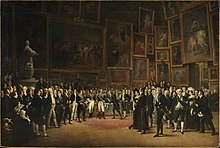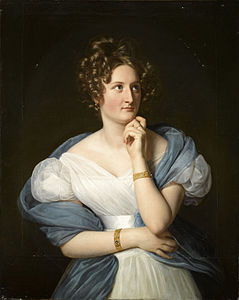This is an old revision of this page, as edited by Lord Cornwallis (talk | contribs) at 12:13, 2 December 2024 (→Gallery). The present address (URL) is a permanent link to this revision, which may differ significantly from the current revision.
Revision as of 12:13, 2 December 2024 by Lord Cornwallis (talk | contribs) (→Gallery)(diff) ← Previous revision | Latest revision (diff) | Newer revision → (diff) Art exhibition in Paris
The Salon of 1824 was an art exhibition held at the Louvre In Paris between 25 August 1824 and 15 January 1825. It took place during the Restoration Era that followed the downfall of Napoleon's French Empire. At the time one of Europe's premier art exhibitions, the Salon was held roughly biennaly at the time. It was the first to be held since Charles X succeeded to the throne earlier the same year. It has been noted as a "".
Exhibition

Amongst French painters there was anticipation over the return of Horace Vernet who had drawn interest at the 1819 Salon. When two of his paintings had been rejected by the committee for the 1822 Salon, he had responded by withdrawing all his entries bar one and went on to hold a private exhibition in his own studios which was a great success. In 1824 he exhibited more than twenty paintings, including older works, that functioned as a retrospective.
Paul Delaroche's Joan of Arc, Sick, Interrogated in Prison by the Cardinal of Winchester depicted a scene from the Medieval era.
Sharp contrast between neoclassical and romantic art typified by Eugène Delacroix's The Massacre at Chios depicting a scene from the Greek Revolution and The Vow of Louis XIII by Jean-Auguste-Dominique Ingres.
Many of the officials, sculptors and painters involved in the 1824 Salon were featured in François Joseph Heim's 1827 painting Charles X Distributing Awards to Artists.
British Salon

For the first time several leading British artists exhibited at the Salon, although J. M. W. Turner was notably absent. Although the British contingent was small, it had a disproportionate influence on reporting of the exhibition. The President of the Royal Academy Sir Thomas Lawrence sent a copy of his Portrait of the Duke of Richelieu featuring a recent French Prime Minister. Richard Parkes Bonington a young Anglo-French artist exhibited five landscapes and was awarded a gold medal. Copley Fielding was also awarded for his watercolors.
Most notably John Constable, a comparatively unsuccessful British artist was hailed for his entries, particularly The Hay Wain
and the director of the Louvre made an unsuccessful attempt to purchase it for the gallery.
At the next Salon in 1827 the British participation was larger, and included Lawrence's The Red Boy and Constable's The Cornfield.
Gallery
-
 A Fishmarket near Boulogne by Richard Parkes Bonington
A Fishmarket near Boulogne by Richard Parkes Bonington
-
 Portrait of the Marquis de Bonchamps by Anne-Louis Girodet
Portrait of the Marquis de Bonchamps by Anne-Louis Girodet
-
 Portrait of Jacques Cathelineau by Anne-Louis Girodet
Portrait of Jacques Cathelineau by Anne-Louis Girodet
-
 The Vow of Louis XIII by Jean-Auguste-Dominique Ingres
The Vow of Louis XIII by Jean-Auguste-Dominique Ingres
-
 Joan of Arc Interrogated by the Cardinal of Winchester by Paul Delaroche
Joan of Arc Interrogated by the Cardinal of Winchester by Paul Delaroche
-
 The Death of the Duke of Berry by Alexandre Menjaud
The Death of the Duke of Berry by Alexandre Menjaud
-
 The Capture of Pamplona by Carle Vernet
The Capture of Pamplona by Carle Vernet
-
 Allan M'Aulay by Horace Vernet
Allan M'Aulay by Horace Vernet
-
 The Battle of Montmirail by Horace Vernet
The Battle of Montmirail by Horace Vernet
-
 Duck Shooting by Horace Vernet
Duck Shooting by Horace Vernet
-
 Psyché by James Pradier
Psyché by James Pradier
-
 Portrait of the Duke of Richelieu by Thomas Lawrence
Portrait of the Duke of Richelieu by Thomas Lawrence
-
 Portrait of Delphine de Girardin by Louis Hersent
Portrait of Delphine de Girardin by Louis Hersent
References
- Harkett & Hornstein p.204
- Harkett & Hornstein p.40-42
- Harkett & Hornstein p.92
- Wolohojian & Tahinci p.354
- Johnson p.614
Bibliography
- Harkett, Daniel & Hornstein, Katie (ed.) Horace Vernet and the Thresholds of Nineteenth-Century Visual Culture. Dartmouth College Press, 2017.
- Johnson, Paul. The Birth Of The Modern: World Society 1815-1830. Orion, 2013.
- Noon, Patrick & Bann, Stephen. Constable to Delacroix: British Art and the French Romantics. Tate, 2003.
- Wolohojian, Stephan & Tahinci, Anna. A Private Passion: 19th-century Paintings and Drawings from the Grenville L. Winthop Collection, Harvard University. Metropolitan Museum of Art, 2003.